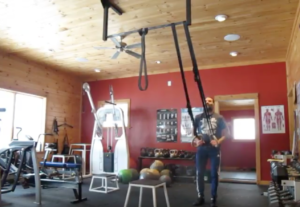April 2017
III. scaling

Recent sunset from Beach Hill Fitness.
Hey everybody,
Do you have an exercise you want to do but just can’t do it or haven’t been able to do it for years? Most people do, including myself.
In this newsletter we will go over exercise scaling for basic bodyweight exercises. These are moves that will help you attain that perfect push-up, impossible pull-up, and mindful air squat.
Happy spring,
Nate
So what is scaling? A method to work towards a fitness goal.
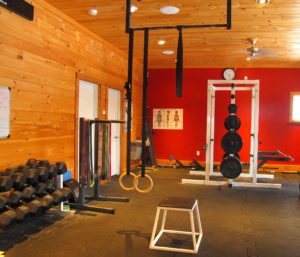
Scaling options for pull-ups.
Scaling, with relation to fitness, means performing an easier exercise in place of a harder exercise. The goal is to one day be able to perform the harder exercise by practicing the easier exercise. One example would be incline push-ups in place of push-ups from the ground. Scaling allows all workouts and exercises to be tailored to anyone’s fitness level.
I follow the workouts on crossfit.com daily and most days do one of the recent posted workouts. I cannot complete every workout as written so I often have to scale my workouts. Some recent examples of my own scaling include pull-ups and dips in place of muscle-ups, strict pull-ups in place of rope climbs, ring-assisted one legged squats in place of one legged squats, handstand shoulder taps in place of handstand walks, and jump rope single-unders in place of double-unders. I will also sometimes lower the weights that are called for. The scale needs to be embraced for one to become a better overall athlete, to reach a fitness goal and, sometimes, to perform a workout safely.
Here is an example of a workout I did, then how I scaled it for both my mom (Gayle) and wife (Natalie):
My workout: As Many Reps As Possible (AMRAP) in 13 minutes of:
- Deadlift 225# x 55 reps
- Wall Balls with 20# Med Ball x 55 reps
- Row for calories x 55 reps
- Handstand push-ups x 55 reps
Gayle’s workout was scaled to the following: AMRAP in 13 minutes of:
- Deadlift 65# x 25 reps
- Wall Balls 14# x 25 reps
- Row for calories x 25 reps
- Incline push-ups x 25 reps
Natalie’s workout was also scaled to the following: AMRAP in 13 minutes of:
- Deadlift 95# x 55 reps
- Wall Balls 10# x 55 reps
- Row for calories x 55 reps
- Incline push-ups x 55 reps
Natalie’s workout was scaled by reducing the weight of the deadlift and wall balls and substituting incline push-ups for handstand push-ups. Gayle’s workout was scaled by reducing the weight in the deadlift and wall balls, substituting incline push-ups for handstand push-ups, and reducing the reps from 55 to 25.
Described below are several bodyweight exercises and the correct scale for each. Also, a video description on pull-up progressions for ways to work towards getting your chin over the bar.
Air squats
- Leg and core workout. Possibly the most functional exercise there is.

Ring-assisted air squat, top of rep.
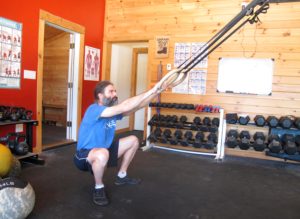
Ring-assisted air squat, bottom of rep.
Air squats are a cornerstone for anyone looking to build lower body and core strength. Once the air squat is attained one can move on to other weight-bearing squats such as the back squat, front squat, goblet squat, or overhead squat.
To do an air squat, set your heels shoulder width apart, toes pointing out from center 30-45 degrees. Take a deep breath at the top of the squat, keep your chest up, head facing forward and weight from the mid to back of your foot as you lower your hip crease to below the top of your knee. Remember to keep your knees out tracking the direction of your toes. Your arms come out in front of you to help with balance. Exhale as you come out of the squat and complete the rep at full hip and knee extension.
If your range of motion is limited or if you just don’t feel stable enough to try a squat without assistance, there are scaling options. Use rings or a bar to assist your air squat. Set up the same way as described above except hold on to the rings or a racked barbell as you lower yourself into the squat. Keep your weight back and lower yourself as low as possible or to a depth where your hip crease is lower than your knee.
Aim for two to three sets of 10-15 reps per set when first starting out. Try to increase range of motion and balance over time so air squatting to proper depth needs no assistance. This exercise should be incorporated into your warmup.
Push-ups
- Upper body and core workout. Most basic pressing exercise.
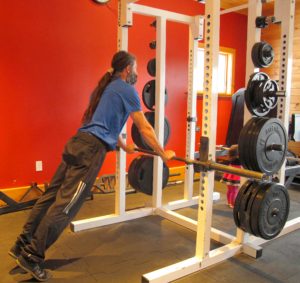
Incline barbell push-up, top of rep.
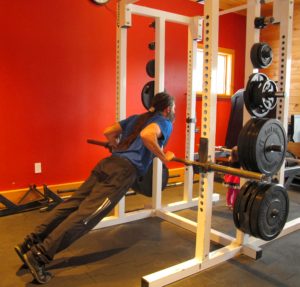
Incline barbell push-up, bottom of rep.
Push-ups are the most widely known and basic upper body pressing exercise. Good form is key to the underlying strength and stability needed for any extended volume of push-ups.
To do a push-up, start with arms fully extended, legs fully extended, hands on the ground placed approximately outside your chest, core engaged, and body rigid as in the plank position. Lower yourself at a moderate pace until your chest and hips touch the floor then raise yourself back to full arm extension. As with any pressing movement, keep your elbows within 45 degrees of your chest; this limits the strain on your shoulders, lessening the risk of injury over time. The closer your elbows come to your chest in the push-up, the more work your triceps are doing. Other keys are to keep your body in a plank-like position so your chest and hips touch the floor at the same time. Don’t try to reach for the floor with any part of your body, let the floor come to you.
If you don’t yet have the strength for push-ups from the floor, incline push-ups using the barbell or rings make an excellent substitution. The movement is the same as described above except you are lowering your chest to the bar (or to the rings) instead of the floor. Ideally, your solar plexus touches the bar (or comes even with the rings) and your body is still in that plank position. You need to find a height for the bar that is comfortable for you yet challenging enough so you feel, upon completion, you could only do a few more reps.
Again, try for two to three sets of 10-15 reps per set when first starting. The ultimate goal is to do a push-up from the floor with legs fully extended. This exercise should be incorporated in your warmup to build core strength and stability and to garner familiarity with the movement.
Dips
- Upper body and core workout. Tougher pressing exercise than push-ups.
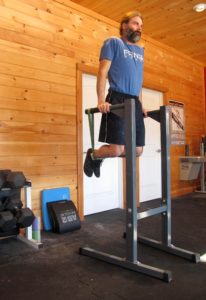
Banded bar dips, top position.
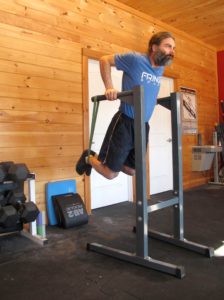
Banded bar dips, bottom position.
Dips are another excellent way to build upper body strength. Dips can be performed on a dip stand, parallel bars, or using rings, and they can be strict in form or kipped (done with a flex of the hip that creates momentum from rep to rep.)
To do a dip, start with your hands grabbing bars on both sides of your hips, your chest forward, knees bent, and elbows behind you. Lower your shoulders to slightly lower than parallel with your elbows. Keep a tight core while you press through your hands and elevate yourself back to full arm extension. Form keys are to keep your chest forward and elbows behind you, not flailing out to the sides.
Those not able to do bar dips yet should scale the exercise using bands attached to each side of the dip stand. You start by looping each end of the band around the arms of the dip stand. Bring the top and bottom of the band together in the center, making sure there is no slack in the line. Step up onto the dip stand and put your ankles on top of the bands. Lower yourself into the dip, keeping chest forward and elbows back until proper depth is reached. When emerging from the dip, press through your ankles into the band, as you are pressing through your hands out of the dip.
Aim for two to three sets of 5-10 reps per set when first starting. The ultimate goal is to do multiple sets of 10 with good form throughout.
Try this: Pull-ups
- Pull-up progression video beginning with ring rows then band pull-ups, jumping pull-ups, strict pull-ups and finally, kipping pull-ups.
If your ultimate goal is to pull your chin over a bar then there are several ways to get there. First, you should begin with ring rows to build up your pulling strength. Find an angle that starts easy but gets challenging by the 10th rep or so. You should be able to do three sets of 15 ring rows before moving on to band pull-ups.
The next progression is band pull-ups. Start with the thickest band you need so you can at least get your chin over the bar once. Ultimately you should be able to do three sets of 10 reps on the thickest band before moving on to thinner bands. Incorporate one set of six reps on a lighter band to begin your progression. From there, work towards three sets of 10 reps on the lighter band before moving to an even lighter band.
You can also work on jumping pull-ups after you have begun progressing on band pull-ups. Try 1-2 sets of 10 reps to start with. Over time, you want to work your way to a set of 50. Jumping pull-ups are a good way to prep for kipping pull-ups because they use your entire body to get over the bar. With strict or band pull-ups, you are mainly using your upper body and core.
The next stage of progression should be strict pull-ups. For some people this goal may take years to attain. It depends where you fall on the fitness spectrum and your desire to achieve this goal. Being able to do more than 10 in a row is a respectable goal to aim for.
A person should be able to do at least one strict pull-up before trying kipping, or gymnastics, pull-ups. Kipping pull-ups are a total body pull-up which raises your heart rate faster than strict pull-ups and allows you to do more reps in a row because of the additional muscles being used, and the momentum gained from rep to rep. Strong hip flex and extension are key to the kipping pull-up. Working up to sets of 15 is an attainable goal.
Practice pull-ups at least once a week to really see some results. I perform two sets of 15 reps of kipping pull-ups in most of my warmup routines. I also typically do at least one other day a week of pull-ups in a workout.
TRY THIS: Workout III
AMRAP* 20 MINUTES
5 Pull-ups
10 Push-ups
15 Air squats
This is a classic Crossfit workout called “Cindy.” My typical warmup for this workout is a 15 calorie row or bike. Pull-ups are usually done kipping style, push-ups are chest to floor, and air squats are with hip crease below top of knee. This workout should start relatively easy but ramp up quickly. By the end you should be exhausted, having trouble catching your breath if you are exerting yourself to the fullest. A great way to get your cardio on using basic bodyweight exercises!
I do this workout once every couple of months. It is a great way to gauge your fitness level. My last attempt, I got through 18 rounds + 15 reps, my all-time best score. My goal is to get above 20 rounds in this workout someday.
Scaled AMRAP* 10 MINUTES
5 Ring rows
10 Incline push-ups
15 Ring-assisted air squats
The basic scaling for the Crossfit “Cindy” workout is listed above. Other scaling techniques for pull-ups include band, jumping, or strict pull-ups. Incline push-ups can be done on a barbell or rings. Air squats can also be assisted using a bar or rings. With any of these movements a decreased range of motion would also be a scaling technique. The time is also scaled to half of the original.
The eventual goal should be to do all the exercises as prescribed in the original Crossfit “Cindy” with full range of motion on each exercise.
This is a great workout if you have limited time to hit the gym that day.
(*AMRAP stands for, “as many reps as possible.” So, if your workout is a 20-minute AMRAP, then you are trying to complete as many reps as possible within those 20 minutes.)
WHAT’S NEW:


